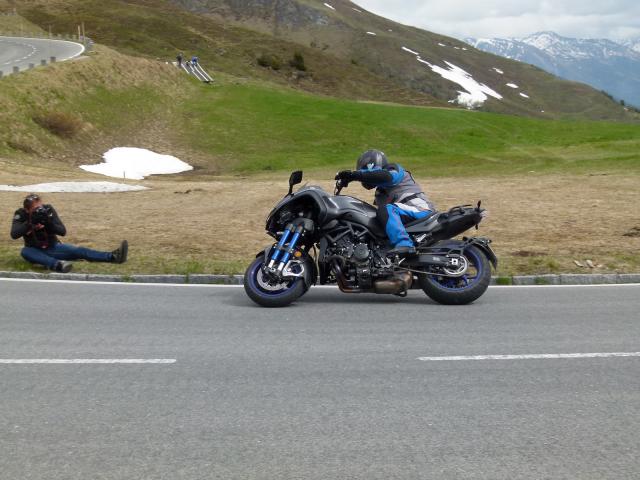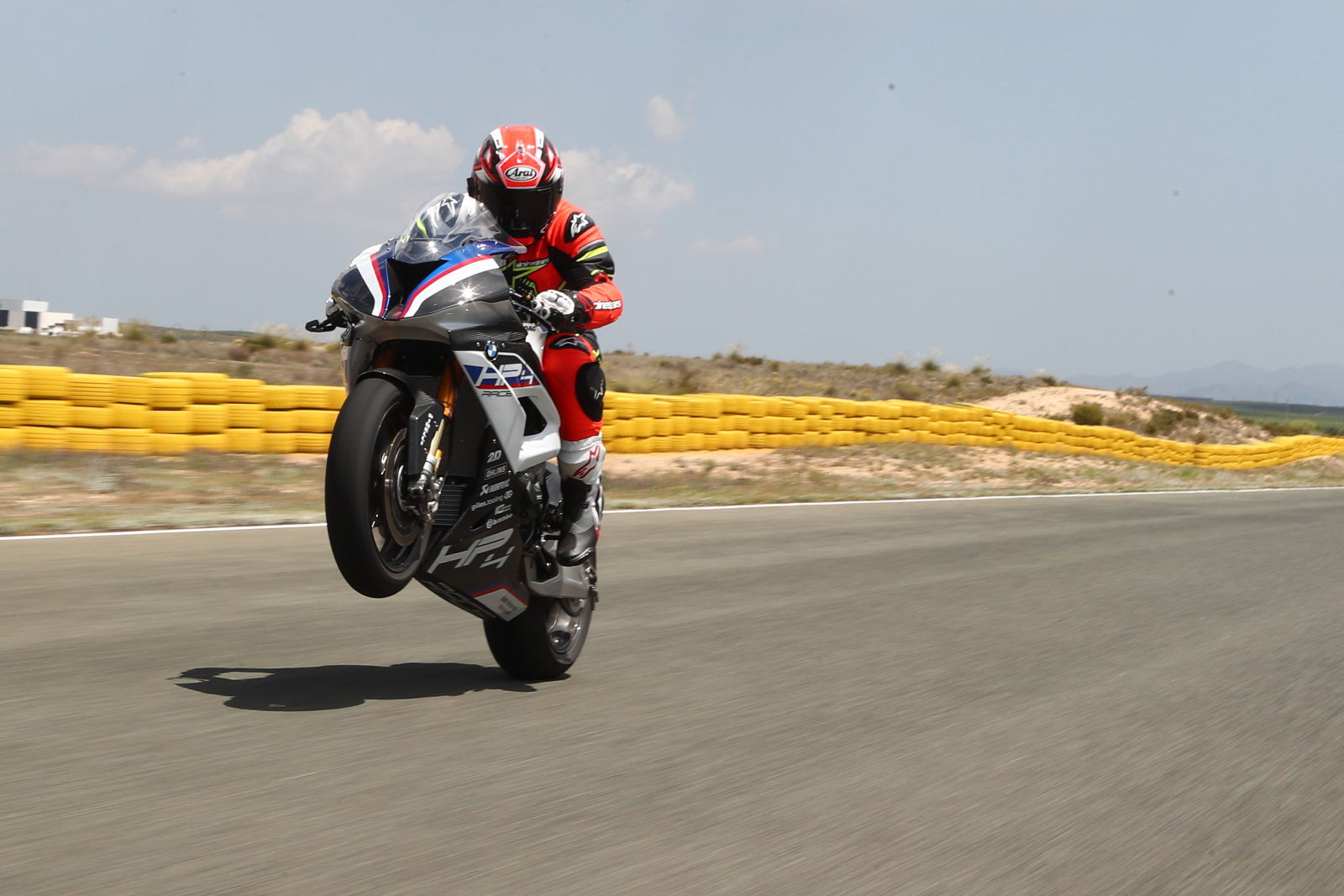Full launch test: 2018 Yamaha Niken
Impressive three wheeler uses hugely interesting technology – but it’s not perfect

Out of all the bike firms, Yamaha is definitely one of the more daring, in terms of technology. Over the decades, it’s brought us two-stroke power valves, aluminium beam frames, five-valve cylinder heads, monoshock rear suspension, ride-by-wire throttles, crossplane crank engines, and much more. And here it is again, shaking things up with a wacky-looking three-wheeled ‘bike’ – the new Niken.

We’ve covered this new machine in-depth since Yamaha announced it as a production bike last year at Milan. So you should have read a fair bit about the basics – it’s a ‘leaning multi-wheeler’, meaning that, yes, it leans over in corners like a ‘proper’ bike, despite having two small 15-inch front wheels, held by a pair of USD fork legs on each side. The front pair of 41mm fork legs is empty apart from some lubricating oil, and serves simply to locate the wheel hubs, with the rear pair of (43mm) legs containing springs and damper units.
The fork legs are attached to a complex-looking parallelogram linkage system under the wide fairing, which takes care of the steering and leaning functions, making sure the wheels point in the proper direction to get you round a bend while leaning like a normal bike would. There’s no damping, electrics, hydraulics or anything else in the linkage system – when you turn the bars, the wheels turn, and the leaning mechanism is totally passive, responding to your steering inputs and leaning the bike over in a natural manner. And unlike some previous three-wheeled scooters, there’s no way to lock the front end in an upright position. If you get off a Niken and forget to put it on the sidestand, it will fall over…
If the front end is totally off-the-wall, the rest of the bike is actually fairly conventional. It’s an MT-09 engine, swingarm, electrics and back end, bolted into a bespoke steel tube and alloy swingarm pivot-plate frame, with the new front end grafted on.

So – it’s a totally new deal in terms of motorcycle chassis design, and one of the most radical interpretations of a ‘bike’ ever made. We’ve all been desperate to see what it’s like to ride, so when the invite came in for the riding launch, I stuck my name down for the jaunt to Austria. Why Austria? Well, the design team reckon that the front end of the Niken is a bit like a set of skis, so they wanted us to go for a ski the day before riding the bike. And the high glacier at Kitzsteinhorn is high enough to still have deep snow in late May. All sounds great – unless like me, you’ve never been skiing before (I’m not including one bus trip to a muddy Glenshee in 1988 here)… So, I spend the day before riding the Niken falling over and cursing the PR men on a frozen mountainside at 3,000 metres. Hmmm.
Of course, Austria has other benefits for riding bikes – an amazing selection of top-notch riding roads, switchbacking up into the mountains and back down again, then along valley floors before hitting the hairpins bends hard again. That selection, plus the chance to ride on less-than-perfect asphalt, and the changeable mountain weather conditions meant Austria made a lot of sense for a design team keen to give us a chance to test the new chassis out on a massive variety of surfaces. And when we woke up on the riding day, it definitely looked like we were going to have a good ‘un. There wasn’t a cloud in the sky over our hotel near Kitzbuhel, but the forecast was all over the place, with thunderstorms, rain, even snow predicted for the route.
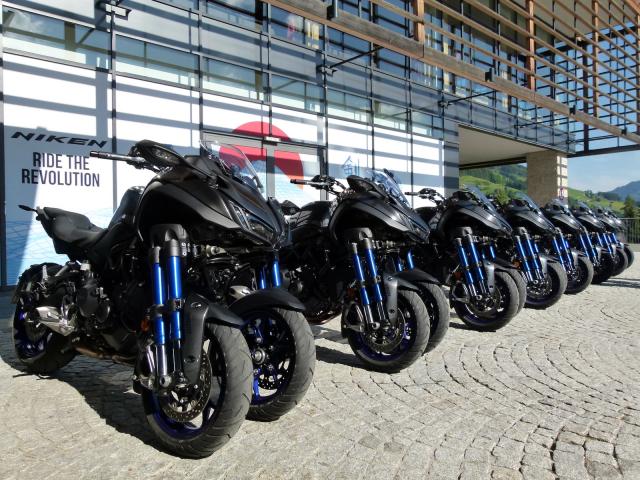
The Nikens are lined up outside, and we’re ready to go. I jump on mine, lift it up off the stand, and try to work out what it feels like. The seat’s a little tall and wide for my stumpy 28” inside legs, and there’s a slightly ungainly feel to the bike, like there’s a lot of weight held forward and high-up. Start the engine, into first, and follow our guide rider out of the car park, and the weird feelings continue. You’re definitely aware there’s something freaky going on, but it’s hard to put your finger on it at first. There’s a hint of big scooter to proceedings, perhaps from the small wheels, plus the feel of a massive mega-tourer, like a BMW LT or Honda Gold Wing. That might be down to the amount of mass being moved when you steer. And the bars are quite wide-set, so there’s a bit of an adventure bike feel too.
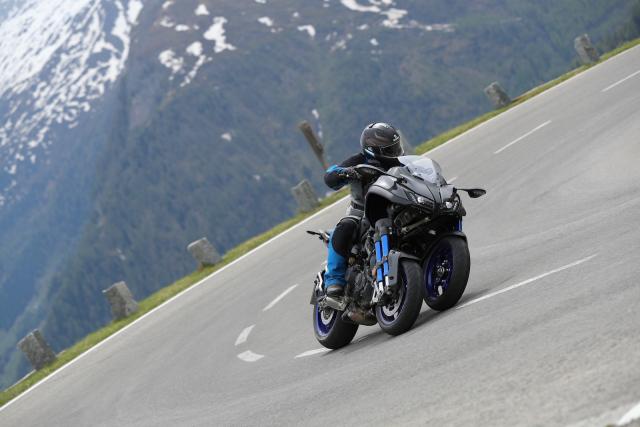
We’re on the move now though, on a fairly steady single carriageway A-road. After a few miles, we start to hit the mountains, and the first (of several thousand it would later seem like) hairpin bends. Piling into the first curve, I give the brakes a bit of a hefty tug for the first time, and am rewarded by a rather dead feel, and less stopping power than I was hoping for. A harder pull on the adjustable-span lever, and the speed scrubs off, but it’s a surprise. Yamahas always have great stoppers, dating back to the famous blue-spot calipers on the old Thunderace of the mid 1990s right up to even the MT-07 budget roadster I was riding a few weeks back. The Niken has a pair of those trademark four-piston monoblock calipers, but the 15” front wheels mean the discs are limited in size – just 265.6mm. The rear is bigger – a 298mm disc – and adding that to the braking equation helps. But this is the first indication that the Niken’s front end comes with unavoidable compromises, both in terms of brake disc size and the added mass that comes with the linkages, extra wheel and fork legs.
We’re well out in the sticks now, and after a coffee stop, we move onto some very nadgery roads indeed. Super-tight hairpins lift us up towards the snowline, and they’re a proper trial. Even on a small, lightweight ‘normal’ bike, they’d be a bit of a challenge – tight, super-steep, blind, dodgy surface. It’s supermoto territory really. But the Niken feels ponderous, and unwieldy in these conditions. Not for the first time, I wanted to have a go at the same road on a standard MT-09, to see how different the Niken chassis is dealing with these tricky stretches.
I’m glad when the roads change again as we get towards the Grossglockner region. The scenery is stunning, the mountains fearsome, and the roads get a bit less niggly. Now, the Niken front end makes a lot more sense. When you can go a bit faster, it seems to work much better, and you can get into the groove. You can feel advantages in terms of much more stability, extra grip, and a secure feeling from the front end. There are parts of the mountain roads where melting snow is making little streams across the asphalt, mid-bend, and where you’d be on tip-toes on a normal bike, the Niken has an extra level of assuredness. Downhill sections in particular are a hoot, and you can really feel like you can push the front into a bend as hard as you like.
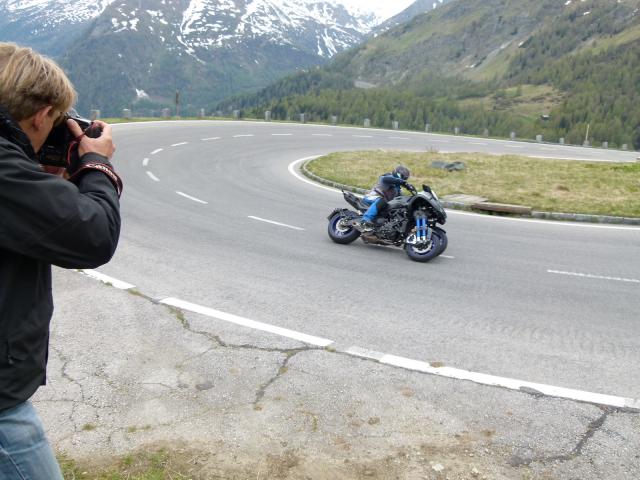
What’s showing up a bit now is the back end though. Yamaha has fitted curious tyres to the Niken – Bridgestone A41s – and it’s quite easy to provoke the traction control into action. Get on the gas hard out of slower bends, and the back spins up, even in the dry. When we get onto some wet roads later on, the rear skips and slides over white lines and overbanding, and you’re definitely left thinking you could do with a grippier hoop out back.
The ‘A’ in the A41 moniker stands for ‘Adventure’ and this tyre is aimed at road-biased use on adventure tourers like the Yamaha Super Tenere and BMW R1200GS. It’s a good fitment on those bikes – but I’m wondering why Yamaha’s chosen a tyre for the Niken that actually says ‘adventure’ on the side, when this is definitely not a big adventure bike. Indeed, Yamaha’s been very insistent that the Niken is a performance-oriented design, aimed at cornering fun, and not touring. If I was looking to ride one of these hard, I’d be wanting to try a sportier Bridgestone option on the back I think.
Riding the last 40-50km back to the hotel, I think about the rest of the Niken for a bit. Obviously, the front end dominates the experience, but there’s plenty of good stuff elsewhere too. The MT-09 engine has been tweaked a little, with a heavier crankshaft, to better tailor the drive characteristics to the heavier bike. There’s cruise control, which is always nice, and an up-only quickshifter (which mostly makes you wish for a down-shifting auto blipper too these days...) The dash is an inverse monochrome LCD unit, which is a little hard to read at times till you get used to it. The screen is small, but the expansive top fairing gives a decent level of wind protection. What you will need is proper waterproof boots when riding in the rain – the two front wheels are directly in line with your feet, and completely deluge your tootsies the instant the road gets even slightly wet.

The mirrors are quite far away, and a faff to adjust on the move, but give a reasonable view behind, while the (nice, aluminium) 18 litre tank will provide a solid amount of range between fill-ups. Lighting is full LED all round, there are three riding power modes and two levels of traction control (plus off). You can wheelie it with the traction off though it takes a load of clutch and a hefty tug – and the traction control setting is of the annoying ‘you have to be stationary to turn it off, and it comes back on whenever you turn off the ignition’ variety. Booh.
Back at the hotel, and we’re done for the day. We’ve done nearly 300km on the Niken, and to be honest, I’m still not really sure if I like it or not. The central question is, are the benefits of the Niken’s chassis design outweighed by the compromises it brings? Those compromises are twofold really – the extra mass, and its position on the bike, plus the small brake discs necessitated by the 15” front wheels. The mass reduces performance, gives a ponderous feeling at slow speeds, and makes it harder to stop (exacerbated by the small discs). On the other hand, there is definitely a benefit in terms of stability, grip and confidence from the two front wheels. Yamaha says there’s 80 per cent more grip over a single 120/70 17 wheel. But how much more grip would you get from swapping out the stock Dunlop Sportmax tyre on an MT-09, say, to a premium sporty road tyre? You’ve already got a decent ABS setup, so in some ways there’s already a safety net for braking into a bend.

What I’d love to try is a Niken where the system has been more optimised – lightweight titanium parts in the steering linkage, a weight-loss program elsewhere on the bike, plus six-piston brake calipers, or a pair of rim-mounted Buell-style discs. There’s definitely something in the idea of a leaning three-wheeler, and if Yamaha could minimise the downsides a bit more, I think they could have a real winner.
But perhaps there’s something else about the Niken front end which will make it a contender for the future. Imagine a self-riding ‘bike’ based on this design. Giving a robot (like the firm’s Rossi-racing Motodroid thingy) a front end like this, with full control over the mechanism, might be an easy way to make it super-controllable. At slow speeds, the computer could lock up the leaning mechanism, so it can’t fall over. Then at higher speeds, actuators could intervene easily to avoid crashes, follow a GPS route, perform ‘active cruise control’, far easier than with a conventional two-wheeled bike and steering system. Food for thought.
And this definitely won’t be the last leaning three wheeler from the tuning fork folks. According to Yamaha, they’re looking to extend the concept further, and you have to think they’ll be improving it all the time too. Whether that will extend to a self-riding version any time soon or not, there will be more Niken-like machines coming.
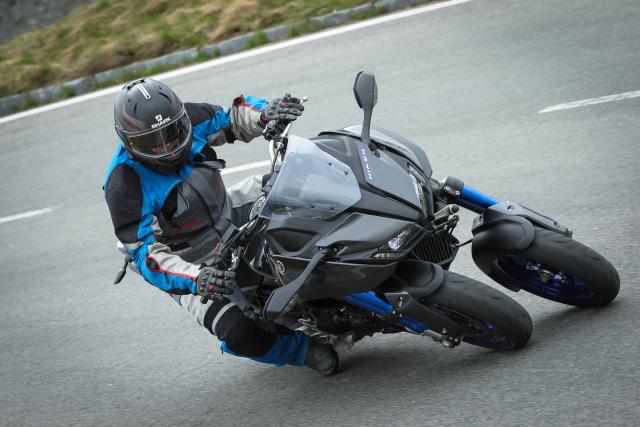
Reading back my notes from the ride, I’m wondering if I’m being a bit too harsh on the Niken. But part of that is down to Yamaha’s positioning of the bike. If they’d sold it as a comfy, safe touring machine, with a confidence-inspiring front end and radical new technology, I’d be putting the performance into a different bracket. Add a taller screen (maybe electric), some luggage on the back, hot grips, and that would better contextualise the heavy feeling at slow speeds and the lack of stopping power from the brakes.
But the PR message was very much that they see this as an exciting, dynamic, performance machine, partly aimed at hardcore cornering fans. And for me, it falls down a little against those parameters. An MT-09SP, with sticky rubber, carbon wheels and Öhlins forks would be lighter, sharper and saucier, and could cost about the same.
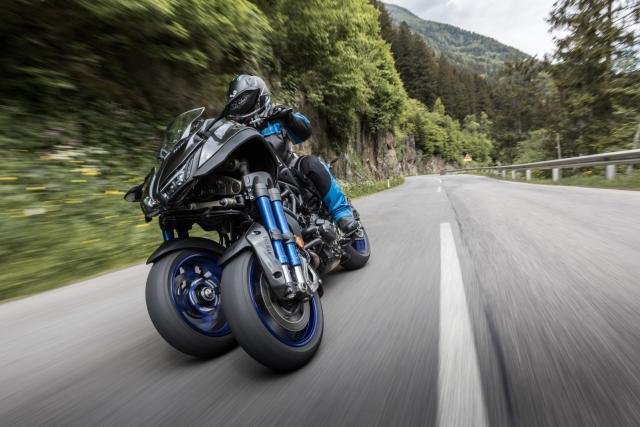
So, Yamaha’s latest daring high-techery is here, and definitely works. Unlike some of the firm’s other innovations though, you really need to try this one out to see if it’s for you. Luckily, Yamaha knows this, and is setting up a European tour, taking truckloads of Nikens round the continent (even Brexity Britain) so people can have a spin on one and try it out. I’d definitely recommend getting on one if you can, and seeing if it suits you and your riding needs.
SPECS
Engine: 12v DOHC, liquid-cooled inline-triple, 847cc
Bore x stroke: 78 x 59.1mm
Compression ratio: 11.5:1
Max power: 115bhp@10,000rpm (claimed)
Max torque: 64.5ft lb@8,500rpm
Transmission: six speed, chain drive
Frame: steel tube/aluminium hybrid
Front suspension: double 41/43mm fully-adjustable USD forks, Ackerman-type parallelogram steering linkage. 410mm track. 45° lean angle.
Rear suspension: preload- and rebound-adjustable monoshock
Brakes: twin 265.6mm discs, four-piston radial calipers (front), single 298mm disc, twin-piston caliper, ABS.
Wheels/tyres: cast aluminium, Bridgestone Battlax A41 120/70 15 front, 190/55 17 rear
Rake/trail: 20° /74mm
Wheelbase: 1,510mm
Wet weight, fully fuelled (claimed): 263kg
Fuel capacity: 18 litres
Price: £13,499
